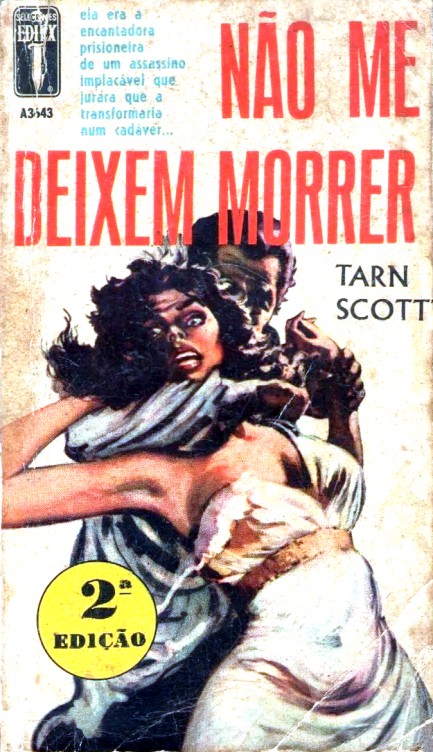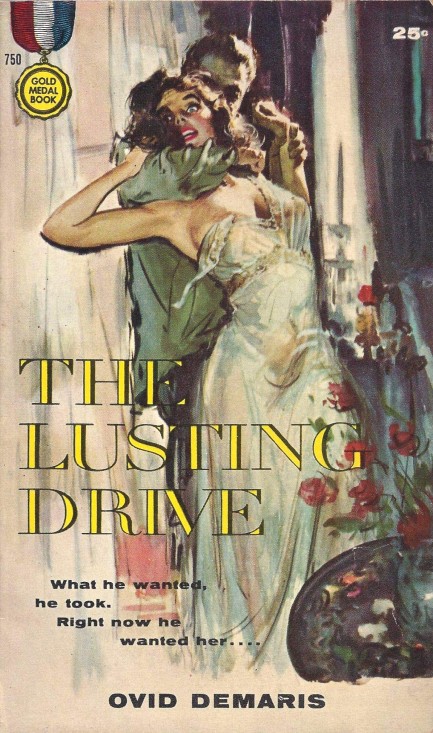 Everybody's gotta go sometime. 
We don't find much Brazilian pulp, but above is an interesting—if battered—cover for Tarn Scott's, aka Walter Szot and Peter G. Tarnor's Não Me Deixem Morrer, which is a translation of their U.S. released 1957 kidnapping tale Don't Let Her Die, a book we read and enjoyed a few years ago. This was put out by the Rio de Janeiro based imprint Ediex for its Selecrimes series in 1964. We gather that Ediex was a branch of the Mexico City publisher Editormex Mexicana, and that the company released quite a few translations of English crime books during the 1960s.
The art, which is by an unknown, is a low rent copy of that found on the cover of 1958's The Lusting Drive by Ovid Demaris, which you see below. That cover is also uncredited, but some think it's by Ernest Chiriacka. We agree. In fact, we don't think there's any doubt. Not only is the style—particularly of the female face—a dead match, but Chiriacka was pumping out illos by the cartload for Gold Medal during the mid- to late-1950s. So we're going to go ahead and call this one a lock. We may share a few more Brazilian paperback covers in a bit. Stay tuned.
 Any of you hardened felons seen my beautiful virginal daughter lately? 
Mitchell Hooks handles the cover work on this Gold Medal edition of the 1957 Tarn Scott thriller Don't Let Her Die. The book concerns a well connected prison inmate who uses his outside-the-walls contacts to kidnap the warden's daughter and maneuver for a pardon in exchange for her life. We say maneuver rather than demand because the convict keeps deniability throughout, claiming to know nothing even as the warden daily receives anonymous ultimatums, with a little extra motivation provided by photos of his terrified daughter nude. The warden caves pretty quickly, appeals to the governor for the pardon, is refused, and that's where things get interesting. There's more grit than usual here, but certain lines will not be crossed, and the reader is well aware of that, despite all the menace injected into the prose. Even so, Scott—a pseudonym used by Walter Szot and Peter G. Tarnor—certainly showed promise. Sadly, the pairing only produced a few books.
|
 |

The headlines that mattered yesteryear.
2003—Hope Dies
Film legend Bob Hope dies of pneumonia two months after celebrating his 100th birthday. 1945—Churchill Given the Sack
In spite of admiring Winston Churchill as a great wartime leader, Britons elect
Clement Attlee the nation's new prime minister in a sweeping victory for the Labour Party over the Conservatives. 1952—Evita Peron Dies
Eva Duarte de Peron, aka Evita, wife of the president of the Argentine Republic, dies from cancer at age 33. Evita had brought the working classes into a position of political power never witnessed before, but was hated by the nation's powerful military class. She is lain to rest in Milan, Italy in a secret grave under a nun's name, but is eventually returned to Argentina for reburial beside her husband in 1974. 1943—Mussolini Calls It Quits
Italian dictator Benito Mussolini steps down as head of the armed forces and the government. It soon becomes clear that Il Duce did not relinquish power voluntarily, but was forced to resign after former Fascist colleagues turned against him. He is later installed by Germany as leader of the Italian Social Republic in the north of the country, but is killed by partisans in 1945.
|

|
|

It's easy. We have an uploader that makes it a snap. Use it to submit your art, text, header, and subhead. Your post can be funny, serious, or anything in between, as long as it's vintage pulp. You'll get a byline and experience the fleeting pride of free authorship. We'll edit your post for typos, but the rest is up to you. Click here to give us your best shot.

|
|









































































